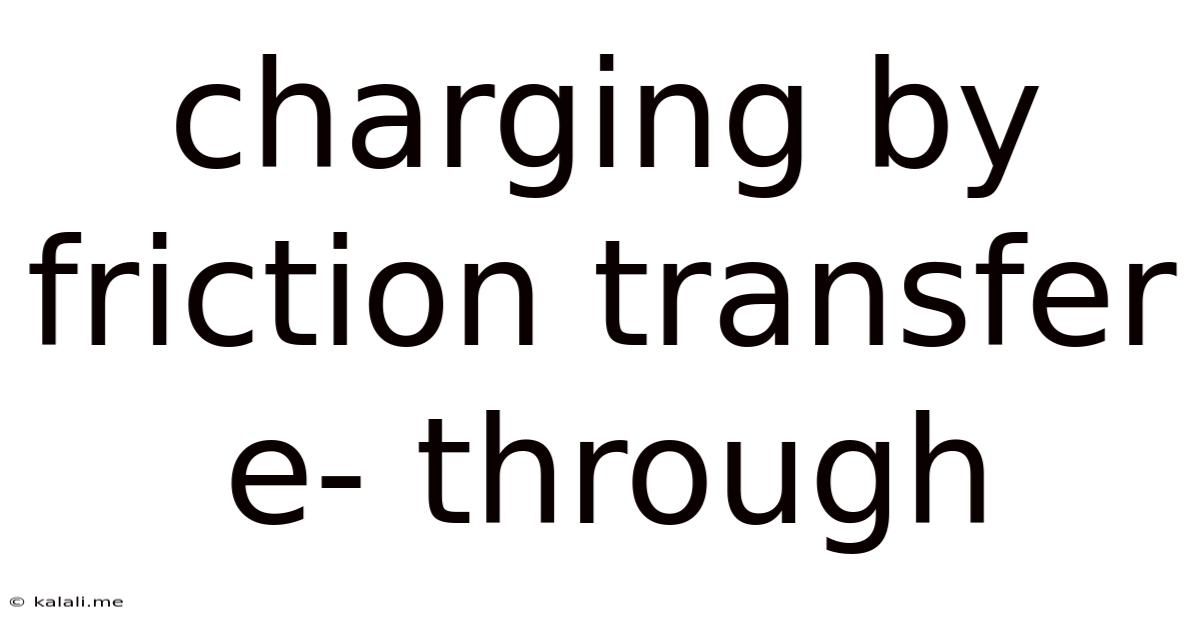Charging By Friction Transfer E- Through
Kalali
Jun 15, 2025 · 3 min read

Table of Contents
Charging by Friction: The Transfer of Electrons Explained
Meta Description: Learn about charging by friction, also known as triboelectric charging, how it works through electron transfer, and its real-world applications and examples. Understand the triboelectric series and how it predicts charge transfer.
Charging by friction, also known as triboelectric charging, is a fundamental process in electrostatics where materials become electrically charged after coming into contact and then separating. This seemingly simple phenomenon is actually a complex interplay of atomic interactions, resulting in the transfer of electrons between the surfaces of the materials involved. This article will delve into the mechanics of this process, explaining the role of electron transfer, the triboelectric series, and real-world examples.
Understanding Electron Transfer
At the heart of charging by friction lies the transfer of electrons. Atoms are made up of protons (positively charged), neutrons (neutral), and electrons (negatively charged). Electrons in the outer shells of atoms, called valence electrons, are relatively loosely bound and can be easily transferred between atoms. When two different materials come into contact, some of these valence electrons can be transferred from one material to the other.
The material that loses electrons becomes positively charged (because it now has more protons than electrons), and the material that gains electrons becomes negatively charged (because it now has more electrons than protons). This transfer occurs due to differences in the materials' electron affinities – their tendency to attract and hold onto electrons. Materials with a higher electron affinity are more likely to gain electrons, while those with a lower electron affinity are more likely to lose them.
The Triboelectric Series: Predicting Charge Transfer
The triboelectric series is a list of materials ranked by their tendency to gain or lose electrons when rubbed against each other. Materials higher on the list are more likely to lose electrons (becoming positively charged), while materials lower on the list are more likely to gain electrons (becoming negatively charged). For example, if you rub glass against silk, the glass will lose electrons and become positively charged, while the silk will gain electrons and become negatively charged.
It's important to note that the triboelectric series is not absolute; the exact charge transfer can depend on factors like surface conditions, temperature, and humidity. However, it provides a useful guide for predicting the outcome of frictional charging.
Real-world Examples of Charging by Friction
Charging by friction is far more common than you might think. Many everyday phenomena demonstrate this principle:
- Walking on a carpet and getting a shock: The friction between your shoes and the carpet causes electrons to transfer, leaving you with a static charge. Touching a metal doorknob then provides a path for the electrons to discharge, resulting in a small shock.
- Static cling in clothes: The friction between clothes in a dryer causes a build-up of static electricity, making the clothes cling together. This is also why clothes sometimes cling to your body after being removed from the dryer.
- Lightning: Although a more complex phenomenon, the initial charge separation in a thunderstorm is thought to involve triboelectric charging between ice crystals and water droplets in clouds.
- Photocopying: The process utilizes the triboelectric effect to charge a photoreceptor drum, enabling the reproduction of images.
Conclusion
Charging by friction is a fundamental electrostatic phenomenon that plays a significant role in many everyday processes. Understanding the principles of electron transfer and the triboelectric series allows us to predict and even control this process, leading to innovations in various fields, from anti-static coatings to advanced printing technologies. While seemingly simple, the process of charging by friction highlights the intricate world of atomic interactions and the fundamental nature of electrical charge.
Latest Posts
Latest Posts
-
How Many Sides Does A Star Have
Jul 01, 2025
-
How Many Ears Of Corn In A Can
Jul 01, 2025
-
What Grade Is A 15 Out Of 20
Jul 01, 2025
-
What Determines The Direction A Pwc Will Travel
Jul 01, 2025
-
How Do You Say Tip In Spanish
Jul 01, 2025
Related Post
Thank you for visiting our website which covers about Charging By Friction Transfer E- Through . We hope the information provided has been useful to you. Feel free to contact us if you have any questions or need further assistance. See you next time and don't miss to bookmark.